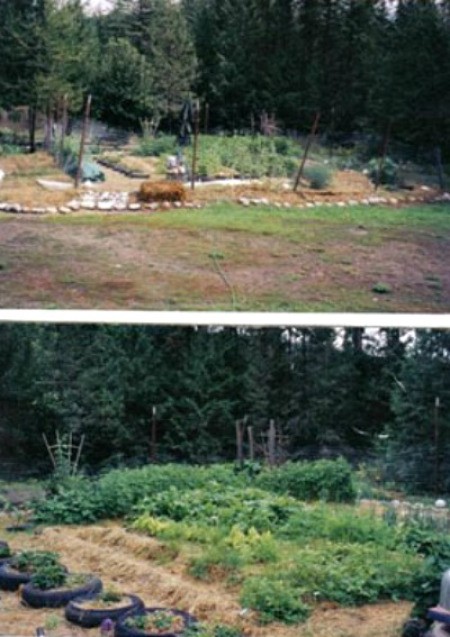For a low maintenance garden I cover my garden with straw. It keeps the weeds away keeps the soil moist all the time. I grow my potatoes in a pile made from straw. It produced the best ever crop for me last year 2004.

Add your voice! Click below to comment. ThriftyFun is powered by your wisdom!
I used to use grass clippings. They are easy to get, and if you don't have enough of your own, the city dump often lets people come to get the grass clippings. Using grass is far cheaper than buying straw, although admittedly, the straw does look nicer. Wood chips are also effective, as long as you are sure that they will decompose quickly enough. But I always found weeding kind of cathartic. It was a time when I could escape from everything and everyone and have some time to myself. With the grass clippings, though, you have to be careful to make sure you aren't using clippings that were treated with potentially toxic pesticides.
Just checking out your tyres Sue. There is an interesting discussion going on at present on the Permaculture Oceania mailing list about tyre use and pollution/leaching of poisons. Some authorities say they are safe, others not. To be certified organic in Australia you aren't allowed tyres near growing areas. An Australian guy has just invented a process to break down waste tyres into their constituent parts, most of which can be recycled.
Anyway - I digress! Great pictures! Your garden looks wonderful - very productive and healthy. I am a big straw fan as well - in fact I have 20 bales out the back awaiting my attention, but its a bit too hot and humid here at the moment!
Regards
Jo
how did you do the potatoes?
Just lay them under the stray and not in the dirt?
Please let me know!
We tried growing potatoes in hay inside a circle of fence that was to be twice the diameter of an armlength last year and had NO LUCK. The idea was to put the potatoes on top of the ground and cover with straw (hay) until the tops came thru and then keep adding it until they reached the top of the fence, keeping it moist, but not soaked. You were supposed to be able to reach your arm thru the holes in the fence and take out potatoes as needed.
The only thing I can think of that we did wrong, was maybe not to keep it wet enough.
Beautiful garden and love the photos. One question, any trouble with deer?

Low-Maintenance Gardening
Judy Camp
A popular trend in gardening today is to go low maintenance. We want a beautiful garden, but a busy lifestyle means we don't have time to tend to it on a regular basis.
"Low-maintenance gardens can be high on impact, and they can be just as stylish as gardens that demand regular attention, "according to Peter McHoy in his 256-page book, Planning Your Garden ( www.paradoxpro.com/
Low-maintenance gardens allow you to leave for a week or more, and the plants can fend for themselves. The most important aspect of a low maintenance garden, besides your choice of plants, is the floor for your garden. "It's important to get this aspect of the garden right, as, initially, it will be the most time-consuming and costly part of planning your garden," McHoy says. "Large areas of the same kind of hard landscaping material will look boring. Be prepared to mix different kinds of paving materials. In Planning Your Garden, McHoy shows how to use various materials to create symmetry in your garden design."
Here are some inspirational ideas for easy gardening:
* Paving: a huge variety of pavers are available, but you will need lots of plants in combination with them to soften the effect. You can pave a walkway through your garden, or create a patio, with plants throughout.
* Gravel and stone: These are best with drough-resistant plants such as lavenders. A few plants go a long way in this type of garden, and maintenance is limited to trimming back any plants that begin to outgrow their space," says Peter McHoy. Lay the gravel thick to keep weeds away.
* Raised beds: These can be used in conjunction with various ground coverings, and can be made of wood, brick, or a number of other materials. Raised beds usually hold a greater depth of soil than do pots or tubs, so plants are less likely to dry out, and it should not be necessary to water a raised bed daily during hot weather, according to the book, Planning Your Garden.
* Use drought-resistent plants: check with your local nursery for the plants that grow best in your climate, and choose the ones that work the best with your garden style.
* Ground-cover plants. "Ground-cover plants are also important 'carpets' for suitable beds and borders," says McHoy. Use plants that do well in your area. Some choices include moss, chamomile, thyme, and even clover.
* Other options include planting through gravel, through gaps in a patio, and against walls.
The number of plants you use, and the size of your low-maintenance garden is up to you. The more plants you use, the more tending they will require. But your initial planning will make a huge difference in the time you need to spend, as well as your enjoyment later in your perfectly designed garden.
About The Author:
Judy Camp is a writer for http://www.paradoxpro.com . The book, Planning Your Garden, can be found at www.paradoxpro.com/
I used straw in my garden and it was a huge success. I went a step further, though, and laid newspaper on the ground first, tearing a slit if necessary to fit around a plant. I wet the newspaper as I laid it down, to keep it from blowing away. Then I laid the straw on top of the newspaper. There are so many advantages to this: we had a drought, and I rarely needed to water because of the excellent mulch; my shoes stayed clean when walking in the garden; the garden looked neat and organized, as yours does; vegetables such as cukes, squash, etc., that run along the ground did not contact dirt and thus did not rot (or get dirty) -- you can even let tomatoes grow without staking if you desire and have the space; and of course, the newspaper (no colored ink of course) and straw break down and enrich the soil. By the way, I tried grass clippings around flowers one year and found that they tend to form a tight mat, they molded, and they didn't allow moisture and air to get to the roots of the plants very well.
Add your voice! Click below to comment. ThriftyFun is powered by your wisdom!